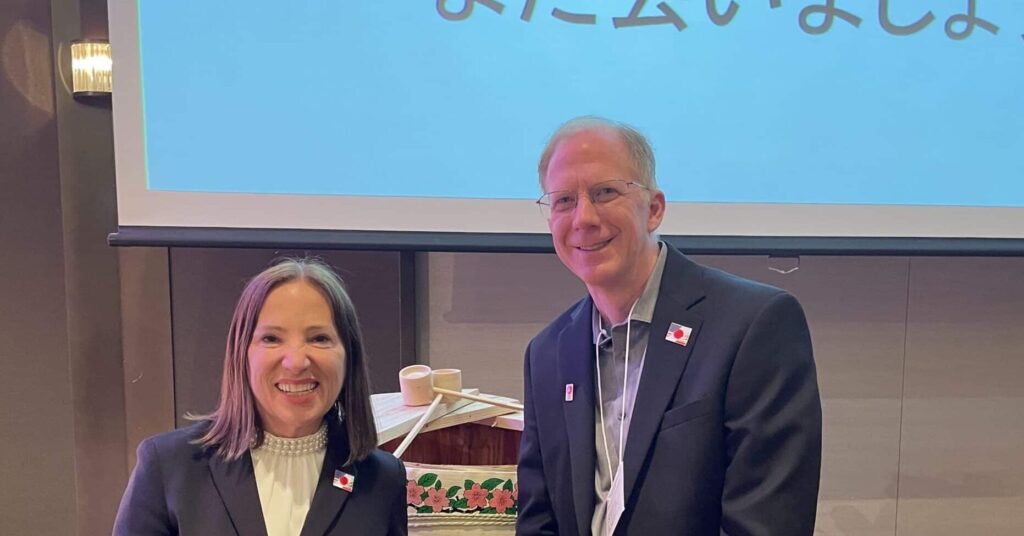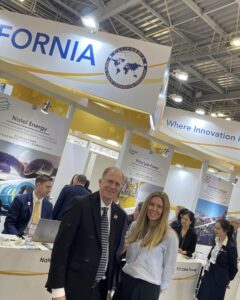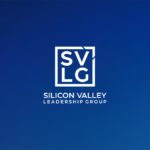By: Tim McRae, SVP, Sustainable Growth at SVLG
Last month I traveled to Tokyo and Osaka as part of the delegation for the California Clean Energy Trade Mission to Japan. The trip was led by California Lieutenant Governor Eleni Kounalakis and Governor’s Office of Business and Economic Development Director Dee Dee Myers and included several Cabinet Secretaries and roughly one hundred representatives from the business sector, including several SVLG member companies. The goal of the mission was to deepen ties with the Japanese on clean energy issues, as well as highlight how California’s leadership on climate and clean energy policy has been beneficial for economic growth.
On March 15, the delegation attended the World Smart Energy Week Exhibition and Conference in Tokyo, which is the largest clean energy trade show in the world with well over 10,000 attendees. At the Conference, I spoke onstage in a California Keynote Session in a panel moderated by Director Myers that also included California Air Resources Board Chair Liane Randolph and California Energy Commission Chair David Hochschild.
The focus of the panel was to showcase the opportunities in California and Japan to transform our economies to run on clean energy. We talked about the work of the many Silicon Valley companies in this space, who are collectively moving us toward California’s goal of carbon neutrality by 2045 and Japan’s recently announced goal of carbon neutrality by 2050. Silicon Valley companies will provide the technologies to get to those goals. Many of the sectors that need to decarbonize already have the technologies commercialized – we have electric cars and charging for them, we can run buildings on renewable energy combined with storage – the question is largely of getting those technologies to be adopted at scale. There are of course a few areas that still need the technologies invented to be fully zero-carbon, such as air travel. Even there, we can see progress, as SVLG members United and Alaska Airlines both spoke about their efforts to increase use of Sustainable Aviation Fuel.
We also spoke about distributed energy resources. These can take the form of micro grids, distributed solar, onsite storage, bidirectional electric vehicle charging, energy efficiency and traditional demand response. Integration of these customer-sited resources, which happens seamlessly in the current Japanese market for demand response (think of it as “demand response plus”), allows customers to reduce demand on the grid and provide additional grid stability. Surplus energy can be stored and discharged to the grid when needed. We’ll have to align incentives at the Public Utilities Commission to get the price signals to do this right in California, but doing so can complement our utility-scale solutions (such as large solar power plants) as we move to electrify the transportation sector and squeeze carbon emissions out of buildings.
There used to be the worry that growing the economy is bad for the environment. As this trade mission proved, there is a thriving clean energy sector in the world’s third largest economy (Japan) and fourth largest economy (which California would be if it were its own nation-state). Continuing progress on our climate goals will help this sector long-term, to the benefit of our economies and the environment.

(Pictured l-r) California Lieutenant Governor Eleni Kounalakis led the recent California Clean Energy Trade Mission to Japan. Tim McRae, SVLG’s SVP of Sustainable Growth, joined the mission to help promote the leadership of Silicon Valley’s clean energy and clean tech businesses.


Dee Dee Myers, Director of California Governor’s Office of Business and Economic Development, and Tim McRae, SVP of Sustainable Growth at SVLG, during the California Keynote Panel discussion. (l-r)
Tim McRae, SVP of Sustainable Growth at SVLG, joins Kris Rosa, Partner at Rostrum, at the California booth at the World Smart Energy Week event in Tokyo. (l-r).



